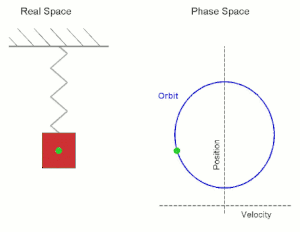From Wikipedia, the free encyclopedia
In mechanics and physics, simple harmonic motion is a type of periodic motion or oscillation motion where the restoring force is directly proportional to the displacement and acts in the direction opposite to that of displacement .
Simple harmonic motion can serve as a mathematical model for a variety of motions, such as the oscillation of a spring. In addition, other phenomena can be approximated by simple harmonic motion, including the motion of a simple pendulum as well as molecular vibration. Simple harmonic motion is typified by the motion of a mass on a spring when it is subject to the linear elastic restoring force given by Hooke's Law. The motion is sinusoidal in time and demonstrates a single resonant frequency. For simple harmonic motion to be an accurate model for a pendulum, the net force on the object at the end of the pendulum must be proportional to the displacement. This is a good approximation when the angle of the swing is small.
Simple harmonic motion provides a basis for the characterization of more complicated motions through the techniques of Fourier analysis.
Introduction
The motion of a particle moving along a straight line with an acceleration which is always towards a fixed point on the line and whose magnitude is proportional to the distance from the fixed point is called simple harmonic motion [SHM].[citation needed]
Simple harmonic motion shown both in real space and phase space. The orbit is periodic. (Here the velocity and position axes have been reversed from the standard convention to align the two diagrams)
In the diagram, a simple harmonic oscillator, consisting of a weight attached to one end of a spring, is shown. The other end of the spring is connected to a rigid support such as a wall. If the system is left at rest at the equilibrium position then there is no net force acting on the mass. However, if the mass is displaced from the equilibrium position, the spring exerts a restoring elastic force that obeys Hooke's law.
Mathematically, the restoring force F is given by
For any simple mechanical harmonic oscillator:
- When the system is displaced from its equilibrium position, a restoring force that obeys Hooke's law tends to restore the system to equilibrium.
As long as the system has no energy loss, the mass continues to oscillate. Thus simple harmonic motion is a type of periodic motion.
Dynamics
For one-dimensional simple harmonic motion, the equation of motion, which is a second-order linear ordinary differential equation with constant coefficients, can be obtained by means of Newton's second law (and Hooke's law for a mass on a spring).Therefore,
Using the techniques of calculus, the velocity and acceleration as a function of time can be found:
By definition, if a mass m is under SHM its acceleration is directly proportional to displacement.
Energy
Substituting ω2 with k/m, the kinetic energy K of the system at time t isExamples
The following physical systems are some examples of simple harmonic oscillator.
Mass on a spring
A mass m attached to a spring of spring constant k exhibits simple harmonic motion in closed space. The equation for describing the periodUniform circular motion
Simple harmonic motion can be considered the one-dimensional projection of uniform circular motion. If an object moves with angular speed ω around a circle of radius r centered at the origin of the xy-plane, then its motion along each coordinate is simple harmonic motion with amplitude r and angular frequency ω.Mass of a simple pendulum

The motion of an undamped pendulum approximates to simple harmonic motion if the angle of oscillation is small.
In the small-angle approximation, the motion of a simple pendulum is approximated by simple harmonic motion. The period of a mass attached to a pendulum of length l with gravitational acceleration
 is given by
is given by ,
therefore a pendulum of the same length on the Moon would swing more
slowly due to the Moon's lower gravitational field strength. Because the
value of
,
therefore a pendulum of the same length on the Moon would swing more
slowly due to the Moon's lower gravitational field strength. Because the
value of  varies slightly over the surface of the earth, the time period will
vary slightly from place to place and will also vary with height above
sea level.
varies slightly over the surface of the earth, the time period will
vary slightly from place to place and will also vary with height above
sea level.This approximation is accurate only for small angles because of the expression for angular acceleration α being proportional to the sine of the displacement angle:






















